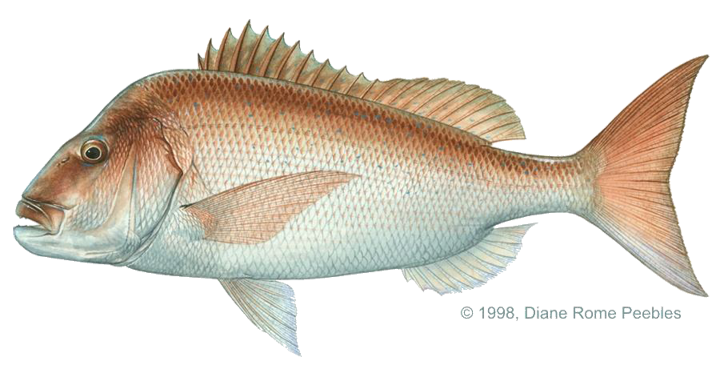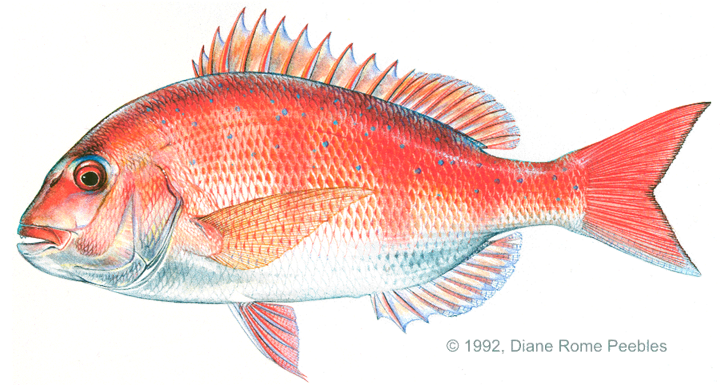Game Fish Identification Reference Guides
Snapper (squirefish)
(Pagrus auratus)
(Pagrus auratus)

(Bloch & Schneider) (formerly Chrysophrys auratus or Pagurus major); SPARIDAE FAMILY; also called pink snapper,
Widely distributed off the southern half of Australia, Lord Howe and Norfolk Islands, and the northern two thirds of New Zealand.
To avoid confusion with snappers in the family Lutjanidae, the American Fisheries Society refers to Pagrus auratus as a squirefish. In Australia, the names cockney, red bream, squire, and snapper or pink snapper are used for progressively larger fish. The name old man snapper refers to very large individuals with a distinctive bony hump on the head and a fleshy bulge on the snout.
The coloration of fresh caught snapper is generally reddish pink with a golden sheen, but color varies somewhat with habitat. Reef dwelling fish are much darker reddish brown where open water fish are a brighter pink, and snapper from soft muddy bottoms can be pale silvery pink.
They inhabit a variety of habitats at all ages, and a moderate depth range as adults. They are coastal fish, commonly found from 20 100 meters but may be right at the surface or down to at least 656 ft (200 m). They reportedly attains a weight of 43 lb (19.5 kg).
Fishing methods vary from surfcasting and jetty fishing to drift fishing, jigging or anchoring and using burley either presented at the surface or attached to an anchor chain. Hooks vary with the size of the fish targeted, from 4/0 for small snapper to 8/0 for real monsters. The hook must be razor sharp for the hard mouthed snapper. They are omnivorous feeders, eating nearly any kind of marine animals, making bait selection fairly easy. Pilchards, skipjack tuna, kahawai, bonito, soldier crabs, or something tough like octopus or cuttlefish work well, but the best baits (and burley) should be reasonably fresh.
They are considered an excellent table fish in New Zealand and Australia
Widely distributed off the southern half of Australia, Lord Howe and Norfolk Islands, and the northern two thirds of New Zealand.
To avoid confusion with snappers in the family Lutjanidae, the American Fisheries Society refers to Pagrus auratus as a squirefish. In Australia, the names cockney, red bream, squire, and snapper or pink snapper are used for progressively larger fish. The name old man snapper refers to very large individuals with a distinctive bony hump on the head and a fleshy bulge on the snout.
The coloration of fresh caught snapper is generally reddish pink with a golden sheen, but color varies somewhat with habitat. Reef dwelling fish are much darker reddish brown where open water fish are a brighter pink, and snapper from soft muddy bottoms can be pale silvery pink.
They inhabit a variety of habitats at all ages, and a moderate depth range as adults. They are coastal fish, commonly found from 20 100 meters but may be right at the surface or down to at least 656 ft (200 m). They reportedly attains a weight of 43 lb (19.5 kg).
Fishing methods vary from surfcasting and jetty fishing to drift fishing, jigging or anchoring and using burley either presented at the surface or attached to an anchor chain. Hooks vary with the size of the fish targeted, from 4/0 for small snapper to 8/0 for real monsters. The hook must be razor sharp for the hard mouthed snapper. They are omnivorous feeders, eating nearly any kind of marine animals, making bait selection fairly easy. Pilchards, skipjack tuna, kahawai, bonito, soldier crabs, or something tough like octopus or cuttlefish work well, but the best baits (and burley) should be reasonably fresh.
They are considered an excellent table fish in New Zealand and Australia













